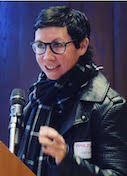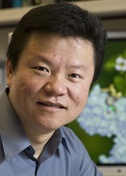Sensing a Change
Brian Crane
Cornell University
Published August 16, 2013
Brian Crane was all set to stay in Canada to attend graduate school when he heard about a new program at the Scripps Research Institute billed as graduate studies "at the interface of chemistry and biology." In 1990, such integrated programs were just emerging, so Crane, a chemist with biochemistry leanings, was intrigued. He had never heard of Scripps, being himself from Manitoba, in Winnipeg, but after a visit to the California campus, he decided the program was a perfect fit.
"The emphasis was chemical, but it had a biology culture," he says. "More freeform and discovery based."
At Scripps, Crane studied metalloenzymes and applied structural biology techniques to trying to understand the catalytic mechanisms of two types of redox enzymes, sulfite reductases and nitric oxide synthases. He focused on trying to characterize the chemical kinetics of the catalytic reactions, such as understanding the timing of protein and electron transfers between cofactors.
Crane continued this work after graduate school in a fellowship at California Institute of Technology, where he combined his background in crystallography with spectroscopic methods and also learned how to use photochemical techniques to initiate electron transfer reactions. He extended this work to begin looking at electron transfer across protein-protein interfaces. "Electron transfer had always been difficult to study in solution," he says. "But in crystals, you can lock everything down and use different tricks to get the electrons to move."
Later, in his own lab at Cornell, where he is now a professor of chemistry and chemical biology, Crane got interested in the broader biological context in which these enzymes operate. He decided to investigate how photochemistry and electron transfer reactions influence two biological sensory systems: light-sensitive circadian clocks and redox-sensitive bacterial chemotaxis.
"What I like about the circadian clocks and chemotaxis systems is the protein networks are tied intimately to the behavior of the organisms," says Crane. "Small changes in these proteins, as much as the mutation of a single residue, can greatly alter behavior, so it gives you a way to go directly from biochemical reactivity to behavior, which is quite amazing."
As an example, in Crane's studies of fungal light sensors, he has developed modified versions of the light-sensing proteins that have different chemical kinetics in response to light and dark cycles. "When we introduce these modifications into the fungi, we see pronounced changes in fungal behavior in terms of circadian rhythms," he says.
To study the circadian clock in a biological context, Crane collaborates with experts in fly and fungal biology. In his own lab, the biggest challenges involve working with the unstable protein complexes that govern these clocks and the large membrane assemblies that provide bacteria with sensory input. "The whole is greater than the sum of its parts," he says. "Figuring out how these proteins work together is a daunting task. You can't quite imagine how they really work by just looking at the pieces."
For instance, in bacterial chemotaxis, the assumption was that the receptors outside the organism talked to downstream effectors in a linear system. But recently Crane's lab defined an elaborate two-dimensional hexagonal lattice inside the membrane that provides the interface. "It works as a huge allosteric enzyme that allows one receptor to activate 35 kinases on the other side," he says. "You can't understand how this works at all unless you grasp the complexity and build up these larger structural models."
To do this work, Crane is integrating X-ray crystallography with electron microscopy and pulsed dipolar electron spin resonance spectroscopy. "It quickly becomes a computational problem," he says. "Often we want to try something new, so we go into SBGrid. Sure enough, there'll be something there that we can use to get started."
-- Elizabeth Dougherty


























































































